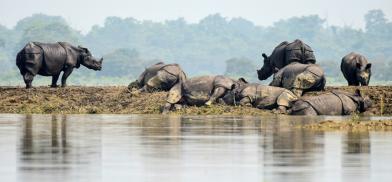Many animals, including rhinos, perished in Assam floods
While the annual monsoon floods in Assam claim hundreds of lives, damage crops, infrastructure and assets, animals too have not been spared

While the annual monsoon floods in Assam claim hundreds of lives, damage crops, infrastructure and assets, animals too have not been spared. These include the endangered rhinos in the world-famous Kaziranga National Park, home to more than 2,200 one-horned Indian rhinos.
Kaziranga National Park Director Karmashree P. Sivakumar said on Tuesday that this year at least 137 wild animals have died so far due to the floods while 163 have been rescued, even as over 95 per cent of the 884 sq km Kaziranga Park was inundated last week. Even with the overall improvement in the flood situation in the state by Tuesday, 75 per cent of the park area remained flooded.
"Last year 263 animals including many endangered rhinos were killed due to the floods while 169 animals were rescued. Currently, we are in the middle of the four-month (June to September) long monsoon. I do not know what would be the final situation. However, all-out efforts are being made to take care of the animals in the entire Kaziranga National Park," Sivakumar told IANS over phone.
The animals that have perished in the monsoon floods this year include 14 rhinos, 101 hog deer, ten wild boars, five wild buffaloes, three porcupines and two swamp deer.
Amidst the natural catastrophe, forest officials and conservation activists had some reason for cheer after photos of a tigress and her two cubs were captured recently on a camera trap inside the Laokhowa Burhachapori wildlife sanctuary, a buffer zone of Kaziranga National Park and Tiger Reserve (KNPTR).
"The first-ever camera trap evidence of successful breeding of tigers in the Laokhowa Burhachapori wildlife sanctuary has boosted the confidence of everyone. This is the result of more than 15 years of hard work and efforts," said Sivakumar who hails from Tamil Nadu.
Located on the south bank of the Brahmaputra river and spread over 114 sq km, Laokhowa Burhachapori lies within KNPTR and the Orang National Park and is part of the Kaziranga Orang Riverine Landscape (KORL), a major gateway for straying animals within protected areas of central Assam.
The famous tiger reserve is 1055 sq km in area of which the national park area is 884 sq km, which is a significant habitat for the endangered rhinos.
Sivakumar said that to protect the animals from the monsoon floods more than 33 highlands had been developed where the animals took shelter after their habitats were inundated.
"Besides, thousands of trained volunteers were engaged during the monsoon period and a Special Protection Force was created for the protection of the rhinos." Over a thousand country boats and speed boats were deployed while additional staff including doctors was mobilised to deal with the floods and safety of the animals, Sivakumar added.
He said that the rising water level in the park had forced three sub-adult tigers to stray into a goat-shed in Kandolimari village and nearby areas earlier this month. "Subsequently, the tigers have been driven back into the park area," Sivakumar said, adding that since the first week of June, there has been no respite from the floods which have wreaked havoc inside the Kaziranga National Park and Tiger Reserve.
Forest officials said that not only the Kaziranga National Park, located on the edge of the eastern Himalayan biodiversity hotspots of Golaghat and Nagaon districts, but the Manas, R.G. Orang and Tinsukia national parks, and the Pabitora and Tinsukia wildlife sanctuaries were also affected and many wild animals died.
Of the 223 camps of forest personnel guarding the Kaziranga National Park, 43 were still inundated on Tuesday despite the flood waters receding.
Each year, the monsoon floods inundating Kaziranga force a large number of wild animals to leave the park and head towards the nearby hills in Karbi Anglong district by crossing National Highway-37 that passes near the park's boundary.
Formed in 1908, the Kaziranga National Park, a Unesco World Heritage site since 1985, is home to more than 2,200 one-horned Indian rhinoceros, approximately two third of the total world population.
Meanwhile, at least 104 persons have died so far in the floods in 22 districts, while 26 others were killed in landslides since May 22. While 22.34 lakh people in 2,026 villages across 22 of the state's 33 districts still remained affected by the floods on Tuesday, the number has come down since Friday when over 28 lakh people in 2,543 villages in 26 districts were hit. Around 14 lakh domesticated animals and over 8 lakh poultry birds were also affected. (IANS)









Post a Comment